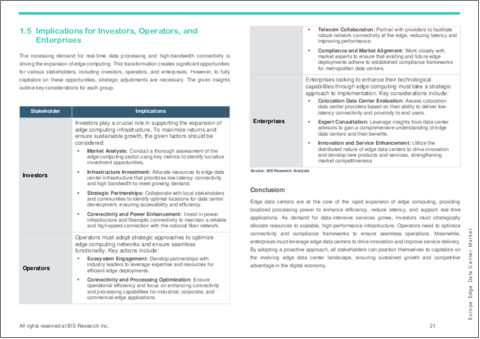|
|
市場調査レポート
商品コード
1732574
欧州のエッジデータセンター市場:製品別、用途別、国別 - 分析と予測(2025年~2034年)Europe Edge Data Center Market: Focus on Product, Application, and Country Analysis - Analysis and Forecast, 2025-2034 |
||||||
カスタマイズ可能
|
|||||||
| 欧州のエッジデータセンター市場:製品別、用途別、国別 - 分析と予測(2025年~2034年) |
|
出版日: 2025年05月23日
発行: BIS Research
ページ情報: 英文 60 Pages
納期: 1~5営業日
|
全表示
- 概要
- 図表
- 目次
欧州のエッジデータセンターの市場規模は、2024年に51億9,440万米ドルとなりました。
同市場は、2034年には286億8,000万米ドルに達すると予測され、予測期間の2025年~2034年のCAGRは18.06%と堅調な伸びを示すとみられています。欧州のエッジデータセンター市場は急速に拡大しており、その主な理由はリアルタイムコンピューティングと低遅延データ処理のニーズの高まりにあります。5Gネットワークの広範な展開、IoTアプリケーションの利用拡大、次世代デジタルサービスをサポートする分散型インフラへの緊急要件のすべてが、この需要に寄与しています。
さらに、プレハブ式やモジュール式のエッジデータセンター設計は、エネルギー効率、拡張性、実装速度が高いことから、この地域で普及が進んでいます。AIを活用した自動化の進展は、予知保全を可能にし、運用効率を高めることで、エッジデータセンターのパフォーマンスを向上させています。
| 主要市場統計 | |
|---|---|
| 予測期間 | 2025年~2034年 |
| 2025年の評価 | 64億3,700万米ドル |
| 2034年の予測 | 286億8,000万米ドル |
| CAGR | 18.06% |
この産業の勢いは、エネルギー効率が高く持続可能なデジタルインフラを支援する国やEUの政策、またインダストリー4.0やスマートシティプロジェクトへの投資によって強まっています。さまざまな業種の企業がエンドユーザーの近くで高性能で拡張性の高い安全なコンピューティングを行うことをより重視するようになり、欧州におけるエッジデータセンターのニーズは今後数年間で飛躍的に高まると予想されます。
欧州では各業界でデジタルトランスフォーメーションが加速しており、エッジデータセンター市場は急速に拡大しています。エッジデータセンターと呼ばれる小規模で分散化された施設は、エンドユーザーやデバイスの近くに設置され、リアルタイムのデータ処理とレイテンシーの大幅な削減を可能にします。5G、モノのインターネット(IoT)、人工知能(AI)、自律システムなど、信じられないほど高速で信頼性の高い処理を必要とする最先端技術のサポートには、このような変化が必要です。
エッジコンピューティングは、スマートシティ、産業オートメーション、コネクテッドインフラストラクチャが成長するにつれて、パフォーマンスと効率を維持するために不可欠になっています。また、データ消費の増加やEUのデータローカライゼーション規制により、組織は都市と地域の両方のハブにエッジデータセンターを設置する必要に迫られています。
エッジデータセンターは、エネルギー効率に優れたテクノロジーとモジュラーアーキテクチャーの技術開発により、持続可能性と拡張性が高まっています。さらに、欧州グリーンディールやデジタル戦略的枠組みのようなEU推進イニシアチブによって、低負荷で高性能なデータインフラの構築が推進されています。
エネルギー供給の制限、細分化された規制、高い運用コストなどの障害にもかかわらず、欧州のエッジデータセンター事業の将来は極めて明るいです。より速く、よりスマートで、より環境に優しいデジタルサービスは、欧州の未来に対応したデジタルエコシステムの柱としての位置づけによって可能になります。
欧州エッジデータセンターの市場動向と促進要因・課題
動向
- AIと5Gの需要:AIアプリケーションと5Gネットワークの普及により、低レイテンシーで分散化されたデータ処理のニーズが高まり、欧州全域でエッジデータセンターの導入が加速しています。
- モジュラー設計とプレハブ設計:モジュール型およびプレハブ型データセンターの採用が加速しており、市場のダイナミックな需要に対応した迅速な展開と拡張性が可能になっています。
- 持続可能性への取り組み:EUのグリーン・ディールや各国の持続可能性目標に合わせて、エネルギー効率の高い運用や再生可能エネルギーの統合が重視されるようになっています。
- セカンダリーマーケットへの進出:フランクフルトやダブリンのような主要ハブのキャパシティに制約があるため、ミラノ、ワルシャワ、ベルリンなどの新興国市場でデータセンターを開発する方向にシフトしています。
促進要因
- デジタルトランスフォーメーション:業界全体でデジタル化が進む中、リアルタイムのデータ処理や分析をサポートする堅牢なエッジ・コンピューティング・インフラが必要とされています。
- スマートシティへの取り組み:スマートシティプロジェクトへの政府投資は、都市のデジタルインフラをサポートするエッジデータセンターの展開を後押ししています。
- 規制による支援:データ主権とローカルデータ処理を促進するEUの政策により、加盟国内でのエッジ施設の設立が奨励されています。
- 遅延に敏感な応用分野:自律走行車や産業オートメーションなど、最小限のレイテンシーを必要とする用途の拡大が、エッジデータセンターの需要に拍車をかけています。
課題
- エネルギー消費:エッジ・データセンターはエネルギー需要の増加に貢献するため、アイルランドの電力消費問題に見られるように、持続可能性や送電網の容量に関する懸念が生じます。
- インフラの制約:適切な場所や電力インフラが限られているため、特定の地域ではエッジ施設の迅速な展開が妨げられます。
- 規制の複雑さ:EU加盟国間の多様な規制環境をナビゲートすることは、プロジェクトの承認を遅らせ、コンプライアンス・コストを増大させます。
- 市民の反対:環境面や美観面での懸念から、データセンター開発に対する地域社会の抵抗が、立地選定やプロジェクト遂行に課題をもたらします。
実践/イノベーション戦略:欧州エッジデータセンター市場のセグメンテーションにより、エッジコンピューティングで使用される技術、インフラタイプ、展開戦略を包括的に理解することができます。オンプレミスエッジ、ネットワークエッジ、地域エッジデータセンターなどの主なコンポーネントにハイライトを当て、これらのソリューションがいかにデータ処理効率を高め、待ち時間を短縮し、リアルタイムコンピューティングをサポートするかを紹介しています。さらに、モジュール式インフラ、エネルギー効率の高い冷却ソリューション、AIを活用したネットワーク最適化など、現在のエッジデータセンターの導入状況を詳細に分析しています。この洞察は、企業や利害関係者がエッジコンピューティングの進化と、スケーラブルで安全かつ高性能なデジタルエコシステムの構築におけるその役割を理解するのに役立ちます。
成長/マーケティング戦略欧州のエッジデータセンター市場では、事業拡大、提携、協業、合弁事業など、市場参入企業による主要な展開が見られます。欧州エッジデータセンター市場における地位を強化するため、各社はパートナーシップ、コラボレーション、ジョイントベンチャーなどの戦略をとっています。
競合戦略:本調査で分析・プロファイルした欧州エッジデータセンター市場の主要企業には、プロジェクト開発企業や会計ツールプロバイダーなどが含まれます。分析では、用途別市場セグメント、タイプ別製品、地域プレゼンス、主要市場戦略の影響などを取り上げています。さらに、詳細な競合ベンチマーキングを実施し、競合各社の比較や市場情勢を明らかにしています。また、欧州のエッジデータセンター市場における未開拓の収益機会を特定するために、提携、合意、協力などの包括的な競合戦略についても検証しています。
主要市場企業と競合情勢
欧州のエッジデータセンター市場でプロファイルされている企業は、一次専門家から収集した情報に基づき、企業範囲、製品ポートフォリオ、アプリケーション、市場浸透度の分析を通じて選定されています。
当レポートでは、欧州のエッジデータセンター市場について調査し、市場の概要とともに、製品別、用途別、国別の動向、および市場に参入する企業のプロファイルなどを提供しています。
目次
エグゼクティブサマリー
第1章 市場
- 動向:現状と将来への影響評価
- エッジデータセンター市場を形成する動向
- 5Gネットワークの展開
- モノのインターネット(IoT)デバイスの普及
- ソフトウェア定義ネットワーク(SDN)技術の採用
- サプライチェーンの概要
- バリューチェーン分析
- 市場マップ
- 研究開発レビュー
- 特許出願動向(国別・企業別)
- 技術分析
- 現在の技術と今後の技術
- エッジ導入数が最も多い主要国
- 時代遅れになる危険性のある技術
- 投資家、事業者、企業への影響
- 規制状況
- ユースケース
- 市場力学の概要
- 市場促進要因
- 市場抑制要因
- 市場機会
第2章 地域
- 地域サマリー
- 欧州
- 欧州の主要市場参入企業
- 地域概要
- 市場成長促進要因
- 市場成長抑制要因
- 用途
- 製品
- フランス
- ドイツ
- 英国
- その他
第3章 市場-競合ベンチマーキングと企業プロファイル
- 競合情勢
- 企業プロファイル
- ATLASEDGE DATA CENTRES
- Proximity Data Centres
第4章 調査手法
List of Figures
- Figure 1: Europe Edge Data Center Market (by End-Use Industry), $Million, 2024, 2027, and 2034
- Figure 2: Europe Edge Data Center Market (by Type), $Million, 2024, 2027, and 2034
- Figure 3: Population Coverage by Technology, 2023 and 2029
- Figure 4: Supply Chain Analysis for Edge Data Center Market
- Figure 5: Patent Filed (by Country), January 2020-December 2023
- Figure 6: Patent Filed (by Company), January 2020-December 2023
- Figure 7: Tottenham Hotspur Stadium, Edge Computing for Smart Stadium Management
- Figure 8: McLaren Racing-Edge Data Computing for Formula One Performance
- Figure 9: Comcast-Edge Computing for Enterprise Resource Planning (ERP)
- Figure 10: Edge Computing for Scalable FinTech Operations
- Figure 11: Villa-Tech-Expanding Cloud Services with Edge Computing
- Figure 12: Impact Analysis of Edge Data Center Market Navigating Factors, 2023-2033
- Figure 13: AI Publications (% of Total) by Sector and Geographic Area, 2021
- Figure 14: Data Generated Annually (Estimated), 2010-2025
- Figure 15: France Edge Data Center Market, $Million, 2023-2034
- Figure 16: Germany Edge Data Center Market, $Million, 2023-2034
- Figure 17: U.K. Edge Data Center Market, $Million, 2023-2034
- Figure 18: Rest-of-Europe Edge Data Center Market, $Million, 2023-2034
- Figure 19: Strategic Initiatives, 2023
- Figure 20: Share of Strategic Initiatives, 2023
- Figure 21: Data Triangulation
- Figure 22: Top-Down and Bottom-Up Approach
- Figure 23: Assumptions and Limitations
List of Tables
- Table 1: Market Snapshot
- Table 2: Edge Data Center Market, Opportunities across Regions
- Table 3: Regulatory Landscape across Countries
- Table 4: Edge Data Center Market (by Region), $Million, 2023-2034
- Table 5: Europe Edge Data Center Market (by End-Use Industry), $Million, 2024-2034
- Table 6: Europe Edge Data Center Market (by Type), $Million, 2023-2034
- Table 7: France Edge Data Center Market (by End-Use Industry), $Million, 2024-2034
- Table 8: France Edge Data Center Market (by Type), $Million, 2023-2034
- Table 9: Germany Edge Data Center Market (by End-Use Industry), $Million, 2024-2034
- Table 10: Germany Edge Data Center Market (by Type), $Million, 2023-2034
- Table 11: U.K. Edge Data Center Market (by End-Use Industry), $Million, 2024-2034
- Table 12: U.K. Edge Data Center Market (by Type), $Million, 2023-2034
- Table 13: Rest-of-Europe Edge Data Center Market (by End-Use Industry), $Million, 2024-2034
- Table 14: Rest-of-Europe Edge Data Center Market (by Type), $Million, 2023-2034
- Table 15: Market Share, 2023
Introduction to Europe Edge Data Center Market
The Europe edge data center market, valued at $5,194.4 million in 2024, is expected to reach $28,680.0 million by 2034, exhibiting a robust CAGR of 18.06% during the forecast period 2025-2034. The market for edge data centres in Europe is expanding rapidly, mostly due to the growing need for real-time computing and low-latency data processing. The extensive deployment of 5G networks, the expanding use of IoT applications, and the urgent requirement for decentralised infrastructure to support next-generation digital services all contribute to this demand.
Additionally, prefabricated and modular edge data centre designs are becoming more popular in the region due to their higher energy efficiency, scalability, and speed of implementation. Advances in AI-powered automation are improving edge data centre performance by enabling predictive maintenance and increasing operational efficiency.
| KEY MARKET STATISTICS | |
|---|---|
| Forecast Period | 2025 - 2034 |
| 2025 Evaluation | $6,437.0 Million |
| 2034 Forecast | $28,680.0 Million |
| CAGR | 18.06% |
The momentum of this industry is being strengthened by national and EU policies that support energy-efficient and sustainable digital infrastructure, as well as by investments in Industry 4.0 and smart city projects. The need for edge data centres in Europe is anticipated to increase dramatically over the next several years as businesses from a variety of industries place a higher priority on high-performance, scalable, and secure computing near end users.
Market Introduction
As Europe speeds up its digital transformation across industries, the market for edge data centres is expanding quickly. Small, decentralised facilities called edge data centres are situated closer to end users and devices, allowing for real-time data processing and a significant reduction in latency. Supporting cutting-edge technologies that require incredibly fast, dependable processing, such 5G, the Internet of Things (IoT), artificial intelligence (AI), and autonomous systems, requires this change.
Edge computing is becoming essential for maintaining performance and efficiency as smart cities, industrial automation, and connected infrastructure grow. Organisations are also being compelled to establish edge data centres in both urban and regional hubs due to the increase in data consumption and the EU's data localisation regulations.
Edge data centres are becoming more sustainable and scalable thanks to technological developments in energy-efficient technology and modular architecture. Furthermore, the creation of low-impact, high-performance data infrastructure is being promoted by pro-EU initiatives like the European Green Deal and digital strategy frameworks.
The future for the European edge data centre business is still quite positive, despite obstacles including restricted energy supplies, fragmented regulations, and high operating costs. Faster, smarter, and greener digital services are made possible by its position as a pillar of Europe's future-ready digital ecosystem.
Market Segmentation
Segmentation 1: by End-Use Industry
- IT and Telecom
- Banking, Financial Services, and Insurance (BFSI)
- Government and Public Sector
- Healthcare
- Manufacturing
- Automotive
- Retail
- Others
Segmentation 2: by Type
- On-Premise Edge
- Network Edge
- Regional Edge
Segmentation 3: by Country
- Germany
- France
- U.K.
- Rest-of-Europe
Europe Edge Data Center Market Trends, Drivers and Challenges
Trends:
- AI and 5G Demand: The proliferation of AI applications and 5G networks is driving the need for low-latency, decentralized data processing, boosting edge data center deployments across Europe.
- Modular and Prefabricated Designs: Adoption of modular and prefabricated data center designs is accelerating, enabling faster deployment and scalability to meet dynamic market demands.
- Sustainability Initiatives: Emphasis on energy-efficient operations and renewable energy integration is growing, aligning with the EU's Green Deal and national sustainability goals.
- Expansion into Secondary Markets: Due to capacity constraints in major hubs like Frankfurt and Dublin, there is a shift towards developing data centers in secondary markets such as Milan, Warsaw, and Berlin.
Drivers:
- Digital Transformation: Increasing digitalization across industries necessitates robust edge computing infrastructure to support real-time data processing and analytics.
- Smart City Initiatives: Government investments in smart city projects are propelling the deployment of edge data centers to support urban digital infrastructure.
- Regulatory Support: EU policies promoting data sovereignty and local data processing are encouraging the establishment of edge facilities within member states.
- Latency-Sensitive Applications: Growth in applications requiring minimal latency, such as autonomous vehicles and industrial automation, is fueling edge data center demand.
Challenges:
- Energy Consumption: Edge data centers contribute to increased energy demand, raising concerns about sustainability and grid capacity, as seen in Ireland's electricity consumption issues.
- Infrastructure Constraints: Limited availability of suitable sites and power infrastructure hampers the rapid deployment of edge facilities in certain regions.
- Regulatory Complexity: Navigating diverse regulatory environments across EU member states can delay project approvals and increase compliance costs.
- Public Opposition: Community resistance to data center developments, due to environmental and aesthetic concerns, poses challenges to site selection and project execution.
How can this report add value to an organization?
Practice/Innovation Strategy: The segmentation of the Europe edge data center market provides a comprehensive understanding of the technologies, infrastructure types, and deployment strategies used in edge computing. It highlights key components such as on-premise edge, network edge, and regional edge data centers, showcasing how these solutions enhance data processing efficiency, reduce latency, and support real-time computing. Additionally, the study offers a detailed analysis of current edge data center deployments, highlighting innovations in modular infrastructure, energy-efficient cooling solutions, and AI-driven network optimization. This insight helps businesses and stakeholders understand the evolution of edge computing and its role in building scalable, secure, and high-performance digital ecosystems.
Growth/Marketing Strategy: The Europe edge data center market has seen major development by key participants operating in the market, such as business expansion, partnership, collaboration, and joint venture. The favored strategies of the companies have been partnership, collaboration, and joint venture activities to strengthen their position in the Europe edge data center market.
Competitive Strategy: Key players in the Europe edge data center market analyzed and profiled in the study include project developers and accounting tool providers. The analysis covers market segments by applications, products by type, regional presence, and the impact of key market strategies. Additionally, detailed competitive benchmarking has been conducted to illustrate how players compare, providing a clear view of the market landscape. The study also examines comprehensive competitive strategies, such as partnerships, agreements, and collaborations, to help identify untapped revenue opportunities in the Europe edge data center market.
Key Market Players and Competition Synopsis
The companies profiled in the Europe edge data center market have been selected based on inputs gathered from primary experts and through an analysis of company coverage, product portfolio, application, and market penetration.
Some prominent edge data center market accounting tool providers have been given here.
- ATLASEDGE DATA CENTRES
- Proximity Data Centres
Table of Contents
Executive Summary
Scope and Definition
1 Markets
- 1.1 Trends: Current and Future Impact Assessment
- 1.1.1 Trends Shaping Edge Data Center Market
- 1.1.2 5G Network Deployment
- 1.1.3 Proliferation of Internet of Things (IoT) Devices
- 1.1.4 Adoption of Software-Defined Networking (SDN) Technology
- 1.2 Supply Chain Overview
- 1.2.1 Value Chain Analysis
- 1.2.2 Market Map
- 1.2.2.1 Edge Data Center Market (by Type)
- 1.2.2.1.1 On-Premise Edge Providers
- 1.2.2.1.2 Network Edge Providers
- 1.2.2.1.3 Regional Edge Providers
- 1.2.2.1 Edge Data Center Market (by Type)
- 1.3 Research and Development Review
- 1.3.1 Patent Filing Trend (by Country and Company)
- 1.4 Technological Analysis
- 1.4.1 Current and Upcoming Technologies
- 1.4.2 Key Countries with the Highest Number of Edge Deployments
- 1.4.3 Technologies at Risk of Becoming Obsolete
- 1.5 Implications for Investors, Operators, and Enterprises
- 1.6 Regulatory Landscape
- 1.7 Use Cases
- 1.8 Market Dynamics Overview
- 1.8.1 Market Drivers
- 1.8.1.1 Minimizing Latency and Bandwidth Usage
- 1.8.1.1.1 Case Study: Comparing Edge Servers and Cloud Locations for Enhanced User Experience
- 1.8.1.2 Increasing Focus on Providing Personalized AI Services
- 1.8.1.1 Minimizing Latency and Bandwidth Usage
- 1.8.2 Market Restraints
- 1.8.2.1 Lack of Consideration of Security-by-Design
- 1.8.2.2 Non-Migratability of Security Frameworks
- 1.8.3 Market Opportunities
- 1.8.3.1 Surge in Investment by Data Center Providers
- 1.8.3.2 Increase in Data Generation
- 1.8.1 Market Drivers
2 Regions
- 2.1 Regional Summary
- 2.2 Europe
- 2.2.1 Key Market Participants in Europe
- 2.2.2 Regional Overview
- 2.2.3 Driving Factors for Market Growth
- 2.2.4 Factors Challenging the Market
- 2.2.5 Application
- 2.2.6 Product
- 2.2.7 France
- 2.2.8 Application
- 2.2.9 Product
- 2.2.10 Germany
- 2.2.11 Application
- 2.2.12 Product
- 2.2.13 U.K.
- 2.2.14 Application
- 2.2.15 Product
- 2.2.16 Rest-of-Europe
- 2.2.17 Application
- 2.2.18 Product
3 Markets - Competitive Benchmarking & Company Profiles
- 3.1 Competitive Landscape
- 3.2 Company Profile
- 3.2.1 ATLASEDGE DATA CENTRES
- 3.2.1.1 Overview
- 3.2.1.2 Top Products/Product Portfolio
- 3.2.1.3 Top Competitors
- 3.2.1.4 Target Customers
- 3.2.1.5 Key Personnel
- 3.2.1.6 Analyst View
- 3.2.1.7 Market Share, 2023
- 3.2.2 Proximity Data Centres
- 3.2.2.1 Overview
- 3.2.2.2 Top Products/Product Portfolio
- 3.2.2.3 Top Competitors
- 3.2.2.4 Target Customers
- 3.2.2.5 Key Personnel
- 3.2.2.6 Analyst View
- 3.2.2.7 Market Share, 2023
- 3.2.1 ATLASEDGE DATA CENTRES
4 Research Methodology
- 4.1 Data Sources
- 4.1.1 Primary Data Sources
- 4.1.2 Secondary Data Sources
- 4.1.3 Data Triangulation
- 4.2 Market Estimation and Forecast





